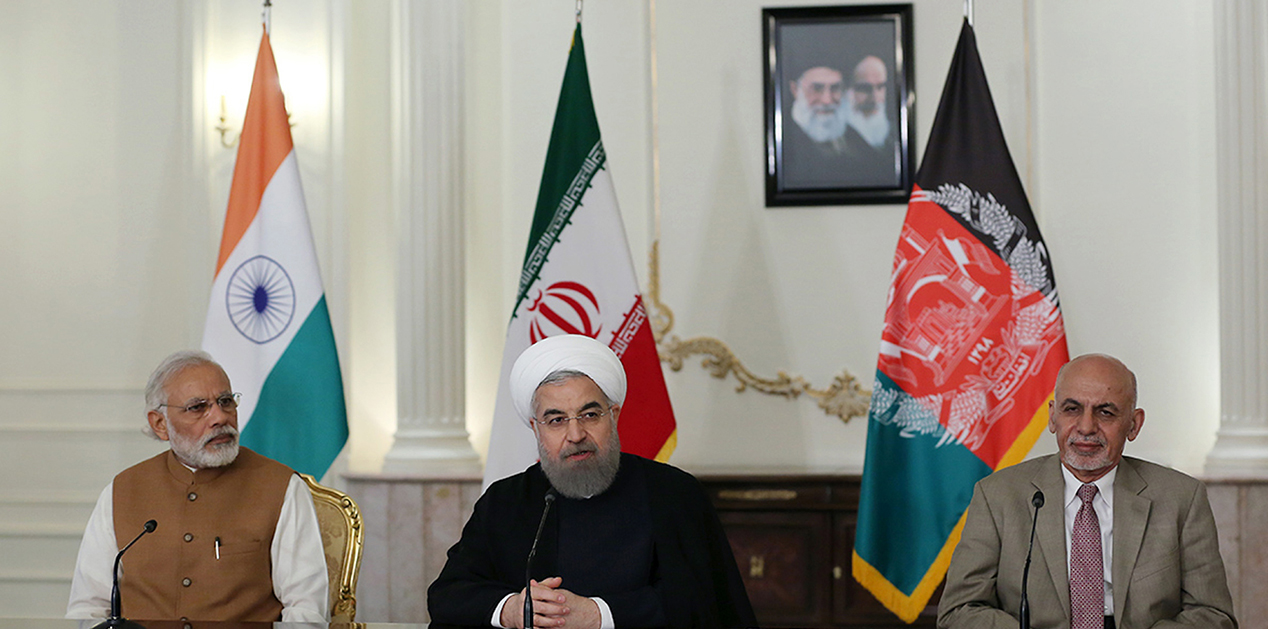The Indian quest for trade route to Iran and Afghanistan extending to Central Asia is about to be realised as the technical teams agreed after negotiations took place among countries in April, 2016 have been finalised.
India, Iran and Afghanistan finalized the provisions of trilateral transport and transit pact called Chabahar. The historical agreement was finally signed in the presence of Narendra Modi, Hassan Rouhani and Ashraf Ghani in Iran on May 23, 2016.

Chabahar is a seaport, located in the southernmost Sistan and Baluchistan province of Iran. The government of Iran has designated Chabahar as Free Trade and Industrial Zone and is 950 km away from Milak near Afghan border. In 2003, India and Iran signed an agreement under which India committed to make bulk of investment to develop the infrastructure of the port. However, the progress of work was very slow due to United States (US) sanctions over Iran. Despite this embargo, India invested $135 million to build Zaranj-Delaram highway in 2009 that connects Kabul-Herat Highway to Chabahar port. In August 2015, upon easing of sanctions against Iran, the road was cleared for India to sign the agreement with Iran to lease and develop the Chabahar port.
The importance of Chabahar can be partly explained through the theory of strategic encirclement. The theory, based on containment, contends that geographic encirclement of a neighbor will suppress its expansion, economic and otherwise. The surrounding country has ample points from which to attack the encircled state, either through military bases or opportunities to impede economic growth by controlling transit routes. As such, India fears strategic encirclement by China while China fears encirclement by the USA. China interprets the US presence in Afghanistan and its alliances with South Korea, Japan, India and Taiwan as attempts towards its strategic encirclement.
On the other hand, India reads Chinese built ports in Sri Lanka, Myanmar, and Bangladesh as attempts to encircle it. Therefore, when China revealed its plans to develop Gwadar port, India went ahead with Chabahar Port Project (around 72 km away from Gwadar) despite international pressure.
The Central Asian region has remained a focus for both China and India who seek to establish their respective regional influence. The region, also popularly known as the Heart of Eurasia, is blessed with abundant natural resources and has significant geo-political and geo-economic strategic importance. India made many attempts to reach Afghanistan and Central Asian markets through Pakistan. It formally requested to join Afghanistan Pakistan Transit Trade Agreement (APTTA), but Pakistan has always been reluctant. Therefore, Chabahar port would serve as a gateway for India to reach Afghanistan and Central Asian markets, bypassing Pakistan.
China, on the other hand, is relying on Gawadar port to establish its Central Asian trade. It started to provide fund and technical expertise on the development of Gawadar port in 2002. It contributed to the bulk development cost of 80 percent of $248 million of Gwadar port on Pakistan’s Arabian Gulf coast. The competing Gwadar and Chabahar ports would provide the two countries access to import natural resources from Central Asia and export their products to these as well as European Union markets.
This strategic competition between powerful countries in the region has offered significant economic opportunities for Afghanistan. As a landlocked country, historically it has relied on Pakistan for trade. However, deterioration of political relations between the two countries has affected trade over the years that has caused heavy loss to Afghan economy. In the same way, the Afghan- India trade through Pakistan has remained low due to restrictions set by Pakistan. In this context, Chabahar will provide a getaway from a trade stalemate situation that can be used as an alternative route for Afghanistan to establish trade relationship with India and other countries. Moreover, the multilateral trade through Afghanistan would fill its coffers with transit fees and duties. In the same way, the project will provide investment opportunities to Afghan investors in Chabahar Free Trade and Industrial Zone.
Afghanistan is blessed with abundant natural resources. The port project will open the gates for Afghanistan to extract and export its mineral wealth as well as develop transport infrastructure. Hajigak mines of Bamyan province are estimated to have iron and other mineral reserves worth over $1 trillion worth. An Indian consortium has bagged the rights of these mines led by Steel Authority of India Limited (SAIL). Further, India plans to construct a 900 km railway which will connect Hajigak region with Chabahar. The connectivity will operationalize the iron and steel project of around $1.8 billion.
The successful implementation and operationalization of Chabahar port project would be a major step for Afghanistan towards economic development and regional integration. The mega infrastructure project has great potential to become a game changer in the region. However, the political and security situation of Afghanistan and the region may hinder the progress of work. Therefore, a collective effort at the regional and international level would be needed to ensure that the planned gains are materialized.
(The author is an Economic Development Advisor/ PPP (USAID- DAI), holding MBA degree in Finance and MSc. in Development Economics from University of Sussex, England. As an analyst, Rahim regularly speaks and writes and about regional political economy for Afghan media)
Published Date: 1st June 2016, Image Source: http://www.hindustantimes.com
(Disclaimer: The views and opinions expressed in this article are those of the author and do not necessarily reflect the official policy or position of the Vivekananda International Foundation)










Post new comment